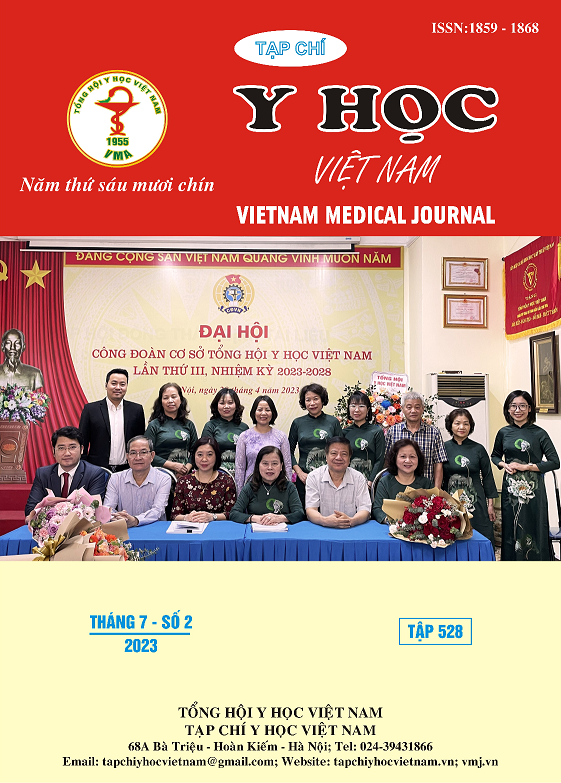CLINICAL MANIFESTATIONS AND ANTIMICROBIAL SENSITIVITY OF BACTERIA IN SEPTICEMIA PATIENTS TREATED AT NATIONAL HOSPITAL FOR TROPICAL DISEASES
Main Article Content
Abstract
A cross sectional study on 300 septicemia patients treated at the Natioanl Hospital for Tropical Diseases during period 2017-2022 to describe the clinical manifestations and to evaluate antimicrobial sensitivity of bacteria causing septicemia. Of them, 71.3% had fever; 89% presented primary local infection, most of them were respiratory, gastroenterology and neurology infection; 48.3% had organ failures including 23% multiorgan failures; 15.7% had septic shock at admission. Key pathogens of septicemia included E. coli (28%), S. aureus (27.3%) and K. pneumoniae (10%). All of E. coli isolates were sensitive with amikacin, carbapenem group, piperacillin-tazobactam. Cotrimoxazole resistance was identified in 76,9% of E. coli isolates and more than 40% of E.coli were resistant to ceftriaxone, cefotaxime, ciprofloxacin and levofloxacin. Almost of K. pneumoniae isolates were sensitive with amikacin, gentamicin, carbapenem, levofloxacin, piperacillin-tazobactam; Ampicillin-sulbactam, ceftriaxone, cefotaxime, tobramycin was found to be sensitive in 80% of K. pneumoniae isolates. For S. aureus, 100% were susceptible to vancomycin, linezolide, nitrofurantoin, quininpristin and more than 90% were susceptible to cotrimoxazole, rifampicin, tigecycline, moxifloxacin; S. aureus resistant to clindamycin (67.9%), cefoxitin (60%), oxacillin (61,7%). All of S. suis were sensitive with ceftriaxone, vancomycin and linezolide; clindamycin and erythromycin resistance were found in 75% and 72,7% of S.suis isolates.
Article Details
Keywords
septicemia, E. coli, K. pneumoniae, S. aureus, S. suis antimicrobial sensitivity
References
2. Rudd KE, Johnson SC, Agesa KM, et al. Global, regional, and national sepsis incidence and mortality, 1990-2017: analysis for the Global Burden of Disease Study. Lancet. 2020; 395 (10219):200-211. doi:10.1016/S0140-6736(19)32989-7
3. Kumar A, Roberts D, Wood KE, et al. Duration of hypotension before initiation of effective antimicrobial therapy is the critical determinant of survival in human septic shock. Crit Care Med. 2006;34(6):1589-1596. doi:10.1097/01.CCM.0000217961.75225.E9
4. Shah PM. PCR for Detection of Bacteremia. Journal of Clinical Microbiology. 2000;38(2):943-943. doi:10.1128/JCM.38.2.943-943.2000
5. Kim SH, Song JH, Chung DR, et al. Changing Trends in Antimicrobial Resistance and Serotypes of Streptococcus pneumoniae Isolates in Asian Countries: an Asian Network for Surveillance of Resistant Pathogens (ANSORP) Study. Antimicrobial Agents and Chemotherapy. 2012; 56(3):1418-1426. doi:10.1128/AAC.05658-11
6. Bộ Y Tế. Hướng dẫn chẩn đoán và điều trị một số bệnh truyền nhiễm, Nhà Xuất bản Y học, Hà Nội, 2016.
7. Aminzadeh Z, Parsa E. Relationship between Age and Peripheral White Blood Cell Count in Patients with Sepsis. Int J Prev Med. 2011;2(4):238-242.
8. Gao Q, Li Z, Mo X, Wu Y, Zhou H, Peng J. Combined procalcitonin and hemogram parameters contribute to early differential diagnosis of Gram-negative/Gram-positive bloodstream infections. Journal of Clinical Laboratory Analysis. 2021;35(9):e23927. doi:10.1002/jcla.23927
9. Chumbita M, Puerta-Alcalde P, Gudiol C, et al. Impact of Empirical Antibiotic Regimens on Mortality in Neutropenic Patients with Bloodstream Infection Presenting with Septic Shock. Antimicrobial Agents and Chemotherapy. 2022;66(2):e01744-21.doi:10.1128/AAC.01744-21
10. Liu Y, Cui B, Pi C, et al. Analysis of prognostic risk factors of bloodstream infections in Beijing communities: A retrospective study from 2015 to 2019. Mediterr J Hematol Infect Dis. 2021;13(1):e2021060-e2021060. doi:10.4084/MJHID.2021.060


